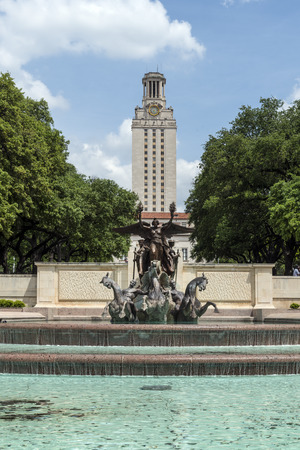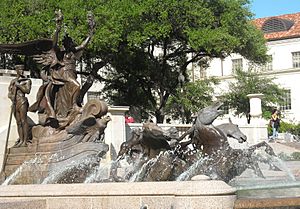Littlefield Fountain facts for kids
Quick facts for kids Littlefield Fountain |
|
|---|---|

Littlefield Fountain in front of the Main Building Tower
|
|
| Artist | Pompeo Coppini (sculptor) Paul Philippe Cret (architect) |
| Completion date | April 29, 1933 |
| Type | Memorial fountain and sculpture |
| Medium | Sculpture: bronze Fountain: granite Fountain wall: limestone |
| Location | Austin, Texas |
| 30°17′02″N 97°44′23″W / 30.28389°N 97.73972°W | |
| Owner | University of Texas at Austin |
The Littlefield Fountain is a special monument at the University of Texas at Austin in Austin, Texas. It's also called the Littlefield Memorial Gateway. This beautiful fountain was designed by an Italian artist named Pompeo Coppini. It was finished in 1933. The fountain is a memorial to honor those who died in World War I. It was named after George W. Littlefield, who was a big supporter of the university and paid for the fountain to be built.
Contents
The Story Behind the Fountain
How the Idea for the Fountain Began
In 1916, a man named Major George W. Littlefield had an idea. He was a former leader at the University of Texas at Austin. He wanted to build a large arch at the university's south entrance. This arch would honor soldiers from the American Civil War who fought for the Confederate side.
In 1919, Littlefield asked Pompeo Coppini, a sculptor from Italy, to design this monument. Littlefield wanted the design to include important people from Texas and the American South. He offered to pay $200,000 for the project.
Designing the Memorial and Changes
Coppini created a design that featured a 40-foot arch. It would have statues of six Confederate figures behind a pool and fountains. But Coppini warned Littlefield that the project would cost more money. Littlefield agreed to increase his donation to $250,000.
On April 15, 1920, Coppini showed university officials a new, cheaper design. This design removed the arch. Instead, it made the fountain pool bigger to hold a large symbolic sculpture. Coppini also convinced Littlefield to dedicate the monument to students and alumni who died in the Great War, which we now call World War I. He believed honoring World War I soldiers would help heal old feelings from the Civil War.
Building the Fountain and Its Dedication
Littlefield passed away in November 1920. Coppini then spent almost ten years creating the sculptures for the memorial. The project faced problems like unexpected costs and delays. There was even a strike by the workers who made the bronze parts.
The six human figures were finished in 1925. They were shown for a short time at the Texas State Capitol. The main sculpture was completed in 1928. Construction of the fountain started in the fall of 1932. The university's architect, Paul Philippe Cret, made some changes to the plan. The six statues were moved to the nearby South Mall. The memorial was officially dedicated on April 29, 1933. The water in the fountain was turned on that March.
What the Fountain Looks Like
The Littlefield Fountain has a fountain in a large, semicircular pool with three levels. A big bronze sculpture rises from the water, with a limestone wall behind it. Water jets spray diagonally onto the sculpture's base from two rows of nozzles.
Symbols and Meaning in the Sculpture
The main sculpture shows the front part of a ship coming out of the stone wall. An eagle sits on the ship's tip. The ship carries a winged figure called Columbia. She holds two raised torches. A soldier and a sailor stand on either side of her.
In front of the ship are three hippocamps, which are mythical horse-like creatures with fish tails. Two of them have mermen riding on their backs. This entire group represents American armed forces sailing to other countries to protect democracy during World War I. The figures and creatures are symbols of American strength and unity.
Messages on the Wall
The limestone wall behind the fountain has two bronze plaques. One plaque lists the names of all the University of Texas students and alumni who died in World War I. It says: "THESE SONS AND DAUGHTERS OF THE UNIVERSITY OF TEXAS GAVE THEIR LIVES TO THEIR COUNTRY IN THE WORLD WAR."
The other plaque has a Latin saying: "BREVIS A NATVRA NOBIS VITA DATA EST AT MEMORIA BENE REDDITAE VITAE SEMPITERNA." This means: "A short life hath been given by Nature unto man; but the remembrance of a life laid down in a good cause endureth forever."
Changes to the Original Design
Coppini's First Vision
In Coppini's first plan, the fountain was supposed to have two 37-foot stone towers, called obelisks, behind it. These towers were meant to represent the Confederacy and the Union. He wanted a statue of Jefferson Davis, a Confederate president, in front of the Confederate tower. Facing him, in front of the Union tower, would be a statue of Woodrow Wilson, an American president. Coppini saw them as two "war presidents." He wanted to show how the United States came back together after the Civil War.
Littlefield also chose other figures for bronze statues around the fountain. These included Confederate generals Robert E. Lee and Albert Sidney Johnston, Confederate postmaster general John Reagan, and Texas governor Jim Hogg. These statues were meant to show important historical figures from Texas and the South.
Why the Design Changed
In the late 1920s, the university leaders decided to remove the obelisks from the plan. One reason was to save money, as the project had gone over Littlefield's donation. Another reason was to keep the view of the university's Main Building clear.
In 1930, the university's architect, Paul Philippe Cret, decided that the six bronze statues Coppini had planned for around the fountain would be placed in different spots along the South Mall instead. He felt the statues would look too crowded around the fountain. Coppini strongly disagreed with these changes. He felt that removing the obelisks ruined the meaning he intended. He also thought that moving the statues made them seem like simple decorations instead of important parts of the memorial.
See also
 In Spanish: Fuente Littlefield para niños
In Spanish: Fuente Littlefield para niños


